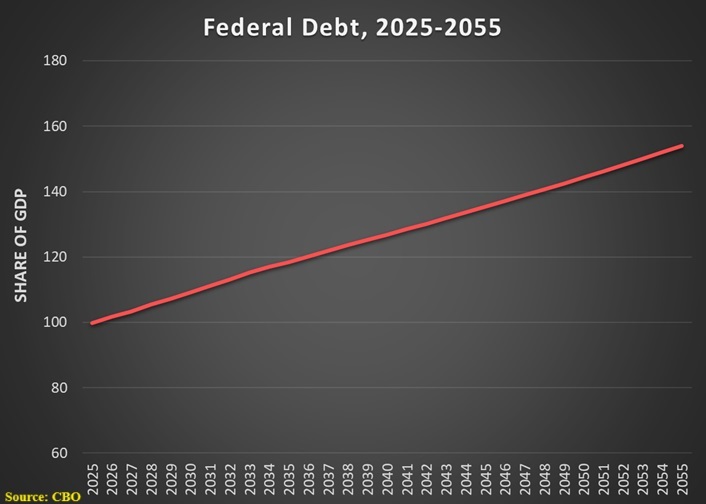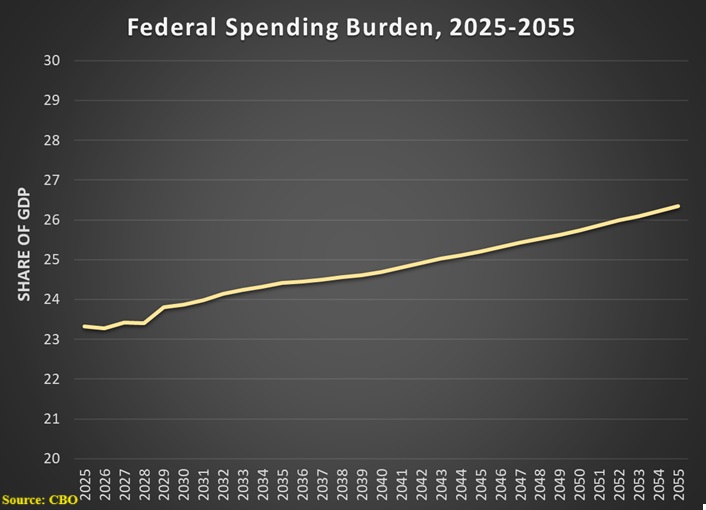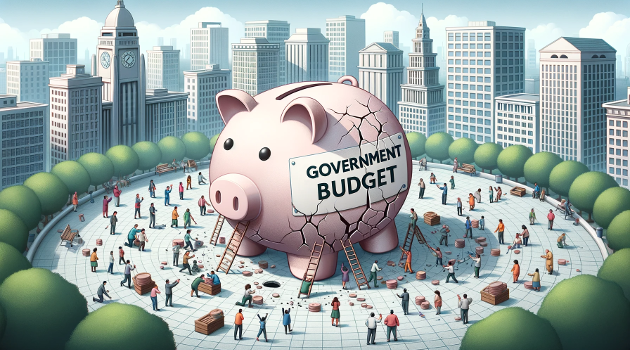When thinking about fiscal policy, most Americans think the country’s biggest problem is rising levels of government debt.
So this chart, based on the Congressional Budget Office’s most-recent 30-year forecast, is what worries them most.

I have a different perspective.
Debt is the symptom. The underlying disease is excessive government.
So here’s the chart, also based on CBO data, that worries me most.

Let’s take one more step in the analysis. The most important thing to understand is that the problem in the first chart would go away if we could fix the problem in the second chart.
In other words, long-overdue fiscal restraint would lead to a shrinking burden of government spending. And, if that happens, then debt stops climbing and eventually begins to decline.
The need for spending restraint was the focus of my column published yesterday by the U.K.-based Telegraph. Here are the most relevant excerpts.
Donald Trump’s…success will probably be determined by the economy. And that means he needs to deal with…fiscal policy. …federal government spending is now consuming more than 23 per cent of America’s economic output, up from less than 21 per cent of GDP before the pandemic. …there will be a big automatic tax increase at the end of this year if the 2017 tax cuts are not made permanent, or at least extended. …the growing burden of government spending has led to $2 trillion annual deficits and record levels of government debt. The good news, relatively speaking, is that spending restraint is the best way of addressing all three. That’s because revenues are projected to grow by an average of 4.5 per cent annually over the next few years. Progress can be made merely by ensuring that spending grows at a slower rate. …That sounds simple, but it’s not easy. Spending restraint means saying no to special interest groups. To meet their fiscal targets, Republicans probably need to impose a hard freeze on domestic discretionary spending, as well as making many more of the cuts that Elon Musk claims to be finding via DOGE. But that’s just the start. Most federal spending today is for so-called entitlements (everything from Social Security to health programmes to redistribution outlays). Trump and his allies will need to reform these programmes if they hope to limit the overall growth of government. …For what it’s worth, Republicans did the right thing during the “Tea Party” era. They managed to freeze overall government spending between 2009 and 2014. If they can do the same thing today, they can make considerable progress on Trump’s three big fiscal challenges. The pessimistic scenario is that the White House and congressional Republicans get squeamish and fail to control spending… At some point, this do-nothing approach will mean a massive fiscal crisis, which presumably will include a big spike in interest rates and lots of turmoil in financial markets.
By the way, I did not pick the title. If I did, I would not have said the United States is “suddenly” in trouble.
We’ve known for a long time about the problem of entitlement spending and demographic change. Heck, my three-part video series was released almost 15 years ago.
But I am fearful that kicking the can down the road for the past 15 years means we are now closer to “big trouble.” Not just America. Other countries as well.


